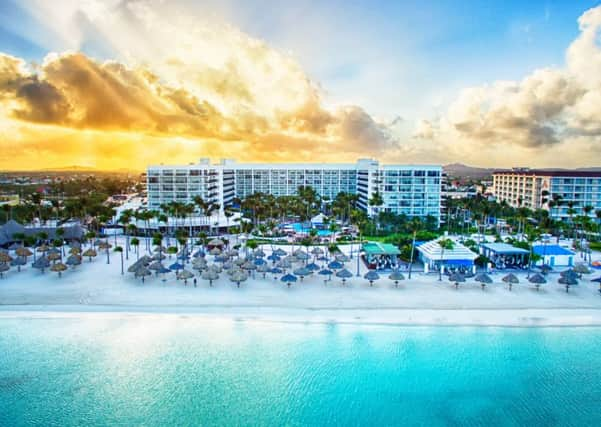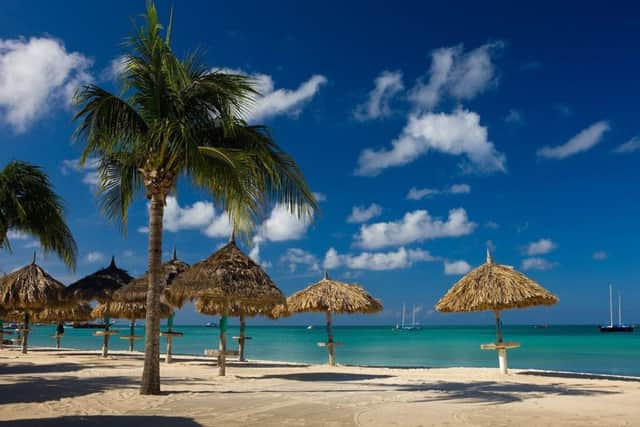Travel: Say hello to eco luxury in Aruba


A small island has a very special relationship with the environment. And when it’s a popular tourist destination that relationship can feel the strain. For Aruba, the Caribbean island in the lee of Venezuela, it’s a delicate equation.
Its glorious white sands, fish-filled waters, wilderness and colourful colonial buildings, together with a tropical climate, have earned it a place in many visitors’ hearts.
Advertisement
Hide AdAdvertisement
Hide AdIts population is about 110,000, yet in one month 90,000 tourists might arrive – admittedly a proportion of them come by cruise ship, but that is still some swelling of numbers living off limited resources.


What is interesting to see is how this island – about the size of East Dunbartonshire in terms of both area and population – copes with, and benefits from, its situation.
Although surrounded by water, Aruba is relatively arid so, as a first step, there is a big desalination plant which provides eight million gallons a day of what is considered one of the best tap waters in the Caribbean.
Aware of its fragile place in the world, the Aruban government has committed to tough sustainability targets.
It aims that the island will be 100 per cent powered by renewable energy by 2020 and with more than 5,000 wind and 2,000 sun hours a year to harness, progress towards clean power has been significant.
The island’s approach to sustainability has not gone unnoticed and Lonely Planet’s Best in Travel, published last month, highlighted the efforts as it placed it fourth in its list of top countries for 2020.
Of course, sustainability comes at a cost and plans for more wind turbines near a popular tourist attraction have had to be rethought.
The sustainable outlook has been embraced by the islanders and their businesses. In many cases, it’s the little things that count – acrylic re-usable cups, no plastic straws, no plastic bags in shops and refilling water bottles from the tap.
Advertisement
Hide AdAdvertisement
Hide AdThere is a $3 per day environmental levy on hotel rooms so we do our bit as visitors and the hotels are making changes as well.
Take the luxurious Aruba Marriott Resort where I’m staying. Public spaces and rooms have energy-saving technology such as automatic thermostats and LED lighting that adapt when an area is unoccupied. Solar power and energy recovery units are used alongside a rigorous waste and recycling regime.
Rooms have been upgraded with noise and heat-proof double glazing, meaning more energy savings – and no stray music if there is a party going on.
Not that most guests will notice all this as they lap up the Aruban hospitality in its benign climate which, unlike many Caribbean destinations, is hurricane-free.
Lazing on the glittering pale sands or gently exploring the clear shallow waters is an addictive way to spend your time and I find no difficulty in getting up at dawn to drink it all in before the sun lounger or paddleboard calls.
Aruba’s hotels fringe the sheltered beaches but on the other side of the island – no more than six miles away – the landscape is very different. The eastern coast is sculpted by the waves that relentlessly crash in.
Exploring this wild side of Aruba is probably best done in a four-wheel drive vehicle and our tour is in a sporty two-seat all-terrain buggy. The rocky coastline of the Arikok National Park has plenty of caves and dramatic natural features to explore.
At one point it hides a sheltered pool where behind a wave-thrashed curtain of rock, bathers swim in gentle waters.
Advertisement
Hide AdAdvertisement
Hide AdIt’s a calm respite from the rugged driving through the eerie desert terrain with its cactus, rocks and scrubland.
Further on, the abandoned Bushiribana gold mill could be from a movie set – except for the truly disgusting toilets which cost a dollar to use. Both the pretty Alta Vista Chapel and the simple California Lighthouse feel more civilised and could be visited in a car.
After all that driving, it feels right to ditch the gas-guzzling vehicles and do a walking tour of the capital, Oranjestad.
Actually it’s much more my thing – chat, local food and a large side-helping of history. And what a fascinating history this island has.
The first Europeans had discovered it by 1499 and it passed through Spanish, Dutch and, briefly, British rule, before becoming Dutch in 1816. As a part of the Kingdom of the Netherlands, it has had autonomy since 1986.
With our “local expert” we meet the characters who shaped its politics and discovered the stories behind its colourful Dutch-style buildings. Another interesting facet of Aruba is its changing economic profile. Through the years it has had income from gold, oil, tourism and aloe vera.
Today it is one of the world’s leading producers of aloe products – and the industry has its roots in the second half of the 19th century when the plant was introduced to the island and used as a laxative. When synthetic laxatives were invented the bottom fell out of the market (so to speak).
For Arubans, who knew that the plant also had healing properties, this potential disaster was an opportunity and today Aruba Aloe’s cosmetic products flourish. On the outskirts of Oranjestad, the company’s fields stretch into the distance and its factory is a fascinating place to tour. The island surprises me in different ways. Take the southern end where the huge oil refinery lies silent after years as a source of steady wealth and employment.
Advertisement
Hide AdAdvertisement
Hide AdSan Nicolas is a small community having to come to terms with the demise of its neighbour. So, what does it do? Invite artists to use its buildings as giant canvases, creating a vibrant open-air gallery.
The art doesn’t limit itself to flat walls and a restaurant has become a house of cards, while the library is turned inside out, even public benches have been transformed with ceramic mosaics. The murals are the legacy of the annual Aruba Art Fair, which returns this month.
Food is a maritime adventure with plenty of freshly landed fish on the menus. The venues are impressive – from dining on the sands at sunset at Passions on the Beach, or in the lush gardens of Papiamento, to the veranda of Screaming Eagle, one of the Caribbean’s top-rated restaurants – and the food is intense in its flavours and invariably beautifully presented.
If the food doesn’t come from the sea, much of it comes over the sea, which highlights another of the island’s dilemmas.
When the borders of crisis-hit Venezuela were closed in early 2019, imports which once had a short sea crossing to Aruba had to come from further afield.
Yet, there is a group of younger Aruban chefs developing a more indigenous cuisine using island-grown produce and inspired by traditional family recipes.
Urvin Croes of White Modern Cuisine explains: “Aruba imports so much, so I wanted to work with island farmers.”
Initially he found there were few people to work with so he – and others – have encouraged farmers to grow produce the chefs would use.
Advertisement
Hide AdAdvertisement
Hide AdSince 2012 the island’s agriculture sector has been growing. Now, aubergines, beans, tomatoes and the local prickly cucumber are harvested and even micro herbs are cultivated.
“If you come to the island you want to eat something local. It is not only the dishes we make, but also being able to eat the products that come from Aruban soil.”
Eating local is certainly an enjoyable way to contain your global footprint in a fragile place.
Aruba Tourism Authority, www.aruba.com
KLM flies from Amsterdam to Aruba daily, with connections from Scottish airports. Return fares from Edinburgh or Glasgow to Aruba from £549, www.klm.com
Aruba Marriott Resort & Stellaris Casino, Palm Beach, Aruba, www.arubamarriott.com – rooms from US$309, subject to availability Aruba Aloe, free factory tours, www.arubaaloe.com
Aruba Art Fair, 22-24 November, arubaartfair.com
Restaurants: Passions on the Beach, www.amsterdammanor.com/passions-on-the-beach; Papiamento, papiamentoaruba.com; Screaming Eagle, screaming-eagle.net; White Modern Cuisine, whitecuisine.com